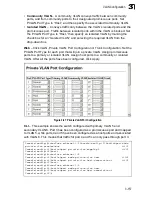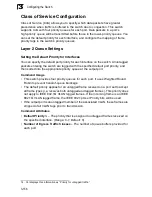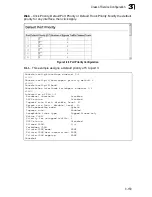
Multicast Filtering
3-171
3
requesting to join the service and sends data out to those ports only. It then
propagates the service request up to any neighboring multicast switch/router to
ensure that it will continue to receive the multicast service. This procedure is called
multicast filtering.
The purpose of IP multicast filtering is to optimize a switched network’s
performance, so multicast packets will only be forwarded to those ports containing
multicast group hosts or multicast routers/switches, instead of flooding traffic to all
ports in the subnet (VLAN).
Layer 2 IGMP
(Snooping and Query)
IGMP Snooping and Query – If multicast routing is not supported on other switches
in your network, you can use IGMP Snooping and Query (page 3-171) to monitor
IGMP service requests passing between multicast clients and servers, and
dynamically configure the switch ports which need to forward multicast traffic.
Static IGMP Router Interface – If IGMP snooping cannot locate the IGMP querier,
you can manually designate a known IGMP querier (i.e., a multicast router/switch)
connected over the network to an interface on your switch (page 3-175). This
interface will then join all the current multicast groups supported by the attached
router/switch to ensure that multicast traffic is passed to all appropriate interfaces
within the switch.
Static IGMP Host Interface – For multicast applications that you need to control
more carefully, you can manually assign a multicast service to specific interfaces on
the switch (page 3-177).
Configuring IGMP Snooping and Query Parameters
You can configure the switch to forward multicast traffic intelligently. Based on the
IGMP query and report messages, the switch forwards traffic only to the ports that
request multicast traffic. This prevents the switch from broadcasting the traffic to all
ports and possibly disrupting network performance.
Command Usage
•
IGMP Snooping
– This switch can passively snoop on IGMP Query and Report
packets transferred between IP multicast routers/switches and IP multicast host
groups to identify the IP multicast group members. It simply monitors the IGMP
packets passing through it, picks out the group registration information, and
configures the multicast filters accordingly.
•
IGMP Querier
– A router, or multicast-enabled switch, can periodically ask their
hosts if they want to receive multicast traffic. If there is more than one router/switch
on the LAN performing IP multicasting, one of these devices is elected “querier”
and assumes the role of querying the LAN for group members. It then propagates
the service requests on to any upstream multicast switch/router to ensure that it will
continue to receive the multicast service.
Note:
Multicast routers use this information, along with a multicast routing protocol such
as DVMRP or PIM, to support IP multicasting across the Internet.
Summary of Contents for 24/48 10/100 Ports + 2GE
Page 2: ......
Page 4: ...ES3526XA ES3552XA F2 2 6 3 E122006 CS R02 149100005500H...
Page 18: ...Contents xiv...
Page 22: ...Tables xviii...
Page 26: ...Figures xxii...
Page 34: ...Introduction 1 8 1...
Page 44: ...Initial Configuration 2 10 2...
Page 242: ...Configuring the Switch 3 198 3...
Page 498: ...Software Specifications A 4 A...
Page 511: ......
Page 512: ...ES3526XA ES3552XA E122006 CS R02D 149100005500H...
















































